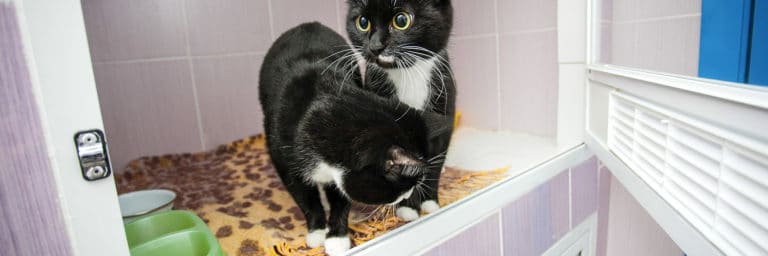Best Flea Collar for Cats : There’s Only 1 We Like…Here’s Why
Contents of Article
For years, flea collars were staples in most cat owners’ medicine cabinets. Flea collars are easier than flea baths, more long-lasting than a pill, and cheaper than spot-on treatments, effectively making parasite control as easy and economical as strapping on a collar.
But that’s changed.
Some veterinarians no longer recommend flea collars at all, considering them more hazardous and less effective than modern spot-on preventives. While most flea collars do more harm than good, there’s one flea collar that’s relatively safe, effective, and recommended by veterinarians. That collar is the Bayer Seresto. We’ll talk about what makes the Bayer Seresto flea collar better than the rest later, but for now, let’s discuss flea collars in general.
Types of Flea Collars for Cats
Introduced in the 1960s, the original flea collar was a resin band infused with time-released insecticides. When wrapped around a dog’s or a cat’s neck, the pesticides spread across the animal’s body and protected him or her from parasitic insects. As the collar became a flea control essential, manufacturers introduced different insecticides, distribution methods, and collar styles.
Today, the market is broken into three main types of flea collars—gas-based, absorption-based, and natural or herbal products.
Gas-Based Flea Collars for Cats
This is the original type of flea collar. Gas-based flea collars emit insecticide gases, killing insects close to the site of the collar. Because of their limited insecticide range, gas-based flea collars aren’t the most effective type you can buy.
Absorption-Based Flea Collars for Cats
Compared to gas collars, absorption-based flea collars have a larger antiparasitic range and tend to be more effective. The chemicals spread from the collar into your cat’s natural oils, which carry the insecticides across the entire body.
Natural and Herbal Flea Collars for Cats
Advertised as a safe, natural alternative to traditional flea collars, these products are typically made from essential oils. The first problem with these flea collars is that they don’t work as well as ordinary flea collars. To add injury to insult, they can be just as harmful as their traditional equivalents. Some essential oils, including those most commonly used as flea repellents, are toxic to cats.
Types of Insecticides in Flea Collars
Flea collars are made from a variety of insecticide chemicals. Though a few appear to be safe for cats, many of them are toxic to more than just fleas—they could also hurt your feline and your family.
Proxopur
Proxopur is a fast-acting, long-lasting insecticide. Though they effectively control fleas, proxopur-impregnated flea collars are as dangerous for you as they are for your cat.
The EPA classifies proxopur as moderately toxic when taken orally and slightly toxic to those who touch or inhale it. The state of California calls it a human carcinogen. Other studies have found that it may be an endocrine disruptor and a reproductive toxin.
Flea collars that contain proxopur:
- Sergeant’s Double Duty Flea and Tick Collar for Cats
- Bansect Flea and Tick Collar for Dogs and Cats
- Scratchex Color-Full Flea and Tick Collar for Cats
- Vet-Kem Breakaway Plus Flea and Tick Collar for Cats
Because the insecticide is dangerous for people and cats, we don’t recommend the use of any proxopur-based flea collars.
Tetrachlorvinphos
Tetrachlorvinphos, abbreviated as TCVP, is an organophosphate pesticide popularly used in flea collars.
It’s one of the most dangerous pesticides you can put on your cat, with potential to harm both you, your cat, and other pets in the home. In 2009, the EPA was petitioned by the Natural Resources Defense Council to end all uses of TCVP in pet products. While these pesticides are still in use, the EPA is currently working with manufacturers to “address these risks”.
Flea collars that contain tetrachlorvinphos:
- Hartz Ultraguard Plus for Cats and Kittens
- Zodiac Breakaway Flea and Tick Collar for Cats
- Adams Plus Cat & Kitten Flea & Tick Collar
- Bio Spot Active Care Breakaway Flea & Tick Collar for Cats & Kittens
Given the severity of tetrachlorvinphos’ potential dangers, it’s best to avoid cat flea collars made with this insecticide. We don’t recommend any tetrachlorvinphos-based flea collars for cats.
Permethrin
Because it’s so toxic to cats, permethrin is more common in dog flea collars than those made for felines. Though most permethrin-based flea collars for cats are less concentrated than those for dogs, they’re still not the safest option.
Whether your cat comes into contact with a dog wearing a permethrin flea collar or wears one himself, permethrin flea collars can poison your cat. Permethrin concentrates in the nervous tissue, causing problems including restlessness, muscle spasms, hypersalivation, and other signs of nervous system distress.
Flea collars that contain permethrin:
- Beaphar Soft Cat Flea Collar
Because permethrin in any amount is dangerous for cats, we don’t recommend any permethrin-based flea collar for cats.
Imidacloprid and Flumethrin
Imidacloprid, the active ingredient in Advantage, is an insecticide that attacks the insect’s central nervous system. Flumethrin is a pyrethroid insecticide that acts like an organophosphate to kill and repel parasites, including ticks and mites.
Compared to other insecticides used in flea collars, imidacloprid and flumethrin appear to be unusually safe. The EPA’s human health assessment found that aside from causing minor skin irritation, flea collars using this combination of ingredients didn’t appear to pose any danger to humans.
Currently, there’s only one flea collar that uses this particular combination of ingredients—the Bayer Seresto Flea and Tick Collar for Cats.
Because it’s apparently safe for both cats and the humans who cuddle them, the Bayer Seresto is the safest and best flea collar for cats. Let’s talk a little bit more about what this collar brings to the flea control battle.
Best Flea Collar for Cats: Our Top (and only) Recommendation
Bayer Seresto Flea and Tick Collar for Cats
Having been launched in 2011, the Bayer Seresto collar is one of the newest additions to the market. It does a few things differently from other flea collars. It destroys a wide range of parasites, lasts for eight months or more, and appears to be among the safest flea control products you can buy.
The Seresto collar is effective against almost every type of external parasite that might affect your cat. It wipes out both adult and larval fleas, along with ticks, sarcoptic mange, and chewing lice.
In two European clinical field studies of over 300 cats, the Seresto flea collar was proven to reduce fleas by at least 95% and ticks by at least 90% for seven to eight months or more.
It’s safe for kittens and adult cats age ten weeks and up. The collar has a breakaway closure to help prevent accidents.
How does the Bayer Seresto flea collar work?
The Bayer Seresto collar is made from a polymer matrix that’s infused with the insecticides imidacloprid (10%) and flumethrin (4.5%).
Like other absorption-based collars, the insecticides in the Seresto collar seep into your cat’s oil glands. As these glands distribute oil across your cat’s coat, they bring along a slow stream of the active ingredients, which spread through the hair and across the skin. When fleas, ticks, and other parasites land on your cat’s body, they come into contact with a deadly dose of toxins.
The collar starts repelling and killing fleas within 24 hours of application. After 48 hours, it repels and kills ticks. The collar keeps working for up to eight months, even if you bathe your cat or he goes out in the sun.
At over $57, the Bayer Seresto flea collar is one of the most expensive flea collars on the market.
Though it’s by far the most reliable and safest flea collar on the market at this time, the Seresto collar is associated with some disturbing reports of its own. Some reviewers on Amazon say that the product caused tremors, irritated skin, bleeding, loss of appetite, and other signs of toxicity.
Pros
- Has one of the best-known safety reputations of all cat flea collars on the market
- Starts working quickly
- Can keep your cat flea-free for the entirety of the flea season
- Non-greasy and comfortable
- Features a quick-release mechanism to help your cat to escape if necessary
- Veterinarian recommended
Cons
- Notably more expensive than most other flea collars
- Not without complaints of rashes, seizures, and other side effects – none of these are confirmed toxicity cases, but the risk is still worth considering
In conclusion, flea collars aren’t the best way to control your cat’s parasite problem.
Though the Bayer Seresto collar appears to be the best flea collar you can buy, it’s not the best flea treatment on the market.
Even if you choose a product that doesn’t contain any of the most harmful insecticides, you’ll still have to worry about the collar catching on something while your cat’s exploring. Even breakaway collars can be dangerous.
Third, all flea collars, including those that haven’t appeared in scary reports from the NRDC or considered carcinogenic by the state of California, come with a disturbing number of reports about raw skin around the neck, hair loss, and seizures. We don’t know if these are legitimate cases of toxicity or not, but the fact that this is so common among flea collars is a reason to look for an alternative flea treatment.
Instead of flea collars, consider the world of oral medications, topicals, and environmental flea killers with less disturbing reputations.
Click here to learn more about the best flea treatments on the market.







